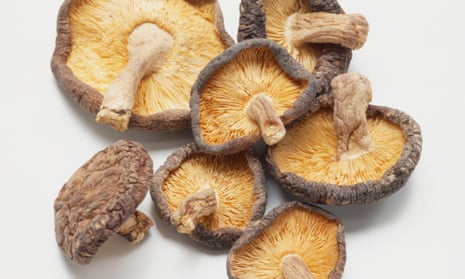My barista hands over a cup filled with grey-tinged milk and a few tiny pieces of fungus bobbing around in it. “Enjoy,” he says with a beaming smile. Enjoy might not be the first thing that springs to mind, but it might be time to get onboard as, over the past year or so, adding a handful of mushrooms to your hot drink, chocolate or energy bar has become an increasingly normal thing for people to do.
Reishi, boletus, cordyceps and lion’s mane sound less like mushrooms and more like things you reluctantly take as a last ditch attempt to clear up a patch of eczema – and, indeed, high claims have been made for their supposed health benefits. Most sellers talk up their products’ antibacterial, antiviral and immune-enhancing properties, but don’t go so big on the fact that, say, cordyceps are parasitic fungi that grow on insects (mmmm, is that my stomach rumbling?).
So, does parasitic fungi grown on insects taste nice when dropped into an espresso? Fans online have described mushroom coffee as tasting somewhere between tea and coffee (which sounds like the kind of thing you get from the Guardian’s office drinks machine no matter what you order), so I headed to Planet Organic in north London for one of its Superfood coffees, a combo of reishi, maca, espresso and hazelnut mylk. The barista describes them as a popular choice: “Not world famous, but they have a … cult following.” As if by magic, the person queuing behind me steps up to order a mushroom coffee. “And she’s not even being paid by the Guardian to do it,” I think to myself.
The drink tastes surprisingly non-weird: there is a slightly unusual bitter finish, but it doesn’t exactly scream: “Oi, you’ve got mushrooms in your drink, you weirdo.”
This lack of mushroomness turns out to be a regular occurrence in the world of shroom food. For instance, you probably wouldn’t detect any mushroom in Pollen and Grace’s hazelnut, praline and reishi Super Square unless you had been forewarned – maybe not even then. The variety of mushroom chocolates I test also taste overwhelmingly funghi-free: Hifas da Terra’s agaricus blazei chocolate tastes like slightly dusty dark chocolate, whereas its chocolate, marron glace and boletus is nothing more alarming than “pleasantly nutty”. Only its chocolate blend of cordyceps sinensis and pollen feels suitably earthy – enjoyable for me as a lover of both mushrooms and weirdness, but arguably less so for my colleagues, whom I caught screwing their faces in disgust as they sampled it. After a week of mushroom eating, the only thing I can find that tastes definitively of mushrooms are Other Food’s slightly more traditional oyster and shiitake chips – whole mushrooms crisped up and marketed as a healthy alternative to crisps.
None of these products come cheap, it should be noted. The chocolate bars could set you back £6 to £8 for a 100g bar, while even the bag of crisps pushes £3. Is it worth it? That really depends how much you believe the health-benefits spiel. To me, the shroom craze appears to be just the latest stage in the wellness era, where increasingly strange-sounding powders and potions are disguised in your drink in return for a hefty price tag. It might make sense to save your cash for making a fancy risotto instead.

Comments (…)
Sign in or create your Guardian account to join the discussion